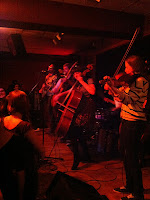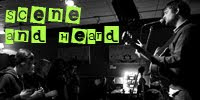Strings. Brass. Bows. Capos. That neck harmonica thing. Flannel shirts. This was to be a spectacle. Somewhere among the tangled hell of amps and chords that occupied the
Casa stage Thursday evening lingered a tangible air of wonder.
Weaving its way through the well-occupied stage into the possibly fire code-violating mass of bodies on the floor, it lasted well into the evening, transcending the drunkenness that typically consumes all by midnight.
Wonder of the musicians, who played with the kind of dexterity usually reserved for concert halls and jazz clubs. Wonder of the audience, which packed together so tightly there was hardly any room for the inevitable dancing. And most of all, wonder at everyone coming together on a cold Thursday night to marvel at the magic made by the people under the red lights shouting, stamping and feeling the primal passion.
After arriving at the show a half hour after the start time as per my custom, I witnessed the syncopated charisma of
Alex Miller. The stripped-down guitar-and-drums combo, despite being as stripped down as a rock format can get, was a vehicle in which he explored the notion of creative covering.
In fact, I entered as he was launching into a mashup of
Tom Petty's "Mary Jane's Last Dance" and the
Red Hot Chili Peppers' "Dani California." Which is a pretty good indication of how little he cared for genre borders.
Smoothing out every space between his notes into a laid-back funk groove, his style of guitar playing seemed to be ready-made for the slowly growing audience to jive along. Avoiding straight 4/4 beats, his drummer played busy dance rhythms that stretched all of his covers out into a slow, easy mood groove. He played all of them on his own terms, too--everyone from
Whitney Houston to the
Beastie Boys got the treatment.
He certainly had swagger. In the middle of his sultry "Let's Get It On" cover, my concert partner and fellow
ACRN writer Justin Silk turned to me and laughed, "Someone's got a little too much self-esteem."
But I think tackling a
Marvin Gaye tune almost implies that. Especially when that self-esteem was used to create such a convincing guitar impersonation of the soul classic.
And the voice. Oh, the voice. Roaring out the rockers, crooning out the ballads, he landed somewhere between
John Frusciante and Kurt Cobain, with a heavy dose of likeability thrown into the mix. It was pure seduction--how could it not be when you cover "Let's Get It On?"
In fact, the several '90s covers he played fit nicely into his party-friendly groove style. "Say It Ain't So," "Two Princes," "Santeria"--it was pretty much a jukebox of radio hits from your childhood. If you want a guaranteed way to warm up a bunch of college kids, play all the poppy rock hits of our childhood that interested us in rock in the first place.
If only he had played "Tubthumping" or "Semi-Charmed Life" he would have hit on almost every post-grunge radio hit of the decade.
Next up was the main course. As the nine members of
The Ridges piled on to the stage, it was clear that they were once again about to bond all the individual drinking, moving bodies of Casa into a single entity under their command.
The banjos, cellos and accordion were all par for the course for this monolith of Athens music, who took its salad bowl of influences and dunked the head of each listener into it.
In fact, from the way the members warmed up on the stage, you would hardly guess that they were about to play the same kind of music, let alone be in a band together.
There was a trumpet player in jazz concert attire playing licks, one member looked straight out of Appalachia with his banjo and flannel shirt, and the drummer was the rocker, sitting down to the kit in jeans and a white shirt.
Always unpredictable, those Ridges. Upon hearing a martial drumbeat, rollicking guitar, or impassioned vocal during the sound check, I always thought they were going to start their first song. But could you blame me, when their songs could start with wild screaming, rapid bowing, or a classical cello solo?
Now, I could tell you that they played songs with titles like "Jackson Pollock," "Dawn of Night" and "Maritime Death Waltz." I could tell you that there was a virtuosic trumpet solo here, pizzicato string plucking there, or a stomping indie beat everywhere. I could mention that they switched between what sounded like 5/8 and 7/8 rhythms.
But that's not what The Ridges are about. Despite having a rock-solid setlist of awesomely-named songs developed in the year since I've first seen them, despite having their technical face together and then some, despite the wide swathe of instruments, none of this was the point.
It was the passion. As proved by everyone on stage. The intense "oh" tribal vocalizations all over every song, the boundless dancing energy of guitarist/singer Victor Rasgaitis, the rapid-fire sawing from the violin and cello players, the tense and heavy slow numbers--this was not a group of songs, this was an experience.
As if any more passion were needed, it was hot. Like really hot. But that's ok, It's pretty much scientifically proven that a concert isn't really good until you feel the need to remove some article of clothing.
Rasgaitis took the opportunity to talk to everyone somewhere in the middle of all of this and asked, "Is anyone feeling hot?"
"That's what happens when you get so many sexy people in one room," responded cellist Talor Smith, to the whooping and hollering of the flattered crowd.
Rather than standing there stiffly like most bands of their ilk, The Ridges pulsated with life. Every single person on that stage, while intently focused on their particular part, was contributing to something far bigger than anyone in the room. At a time when indie bands' limited formulas burn out after an album or so, this band has created a boundless frontier for themselves, one not built on posture or gimmicks, but on drive.
And, as usual, they ended with reminding us that "we'll all be dead in the end." But instead of leaving on that carpe diem-flavored note, they brought back their grand old tradition of dancing on chairs. Rasgaitis boldly stood on a chair in the middle of a crowd who turned in on themselves to stare at the frontman while the rest of his group provided accompaniment back on the stage.
Showmanship at its finest.
After an
O'Betty's break, I came back and watched the
Seedy Seeds, a Cincinnati band who "want world domination, but don't want to be jerks about it."
Well, their machine for Casa domination was well-oiled. Providing live bass and banjo to an endless array of drum and synthesizer loops, they entertained the hardy showgoers who were still there when they took the stage around 1:00.
Proving that classic college rock is not dead, they played the kind of slightly neurotic, politically correct pleasantries that you thought no one had attempted since
10,000 Maniacs and
R.E.M. It was loud, but relaxing, and it was nice to just sit and soak it in after the primal stomping of The Ridges.
They played a '90s cover as their last song, too, saying it was in tribute to the aforementioned Alex Miller. I'm sorry. I don't know what it was. I don't know how I can speak to all of you children of grunge when I don't know my
Superchunk from my
Superunknown.
Even though every single person was drained stepping out of the bar after the four-hour show, the wonder never left. That so many talented people with such varying musical philosophies and approaches could be thrown together for a night by a turn of fate, contributing an entirely singular event in the history of music and then going their separate ways, that was a wonder.
That a bunch of people plucking at strings to create vibrations could grab hold of the attention of nearly the entire city, there was wonder too.
And most of all, the wonder that we live in an age when such complete, concentrated, prodigious musical experiences can be delivered to us weekend after weekend and then vanish into air. We don't know what we have.





